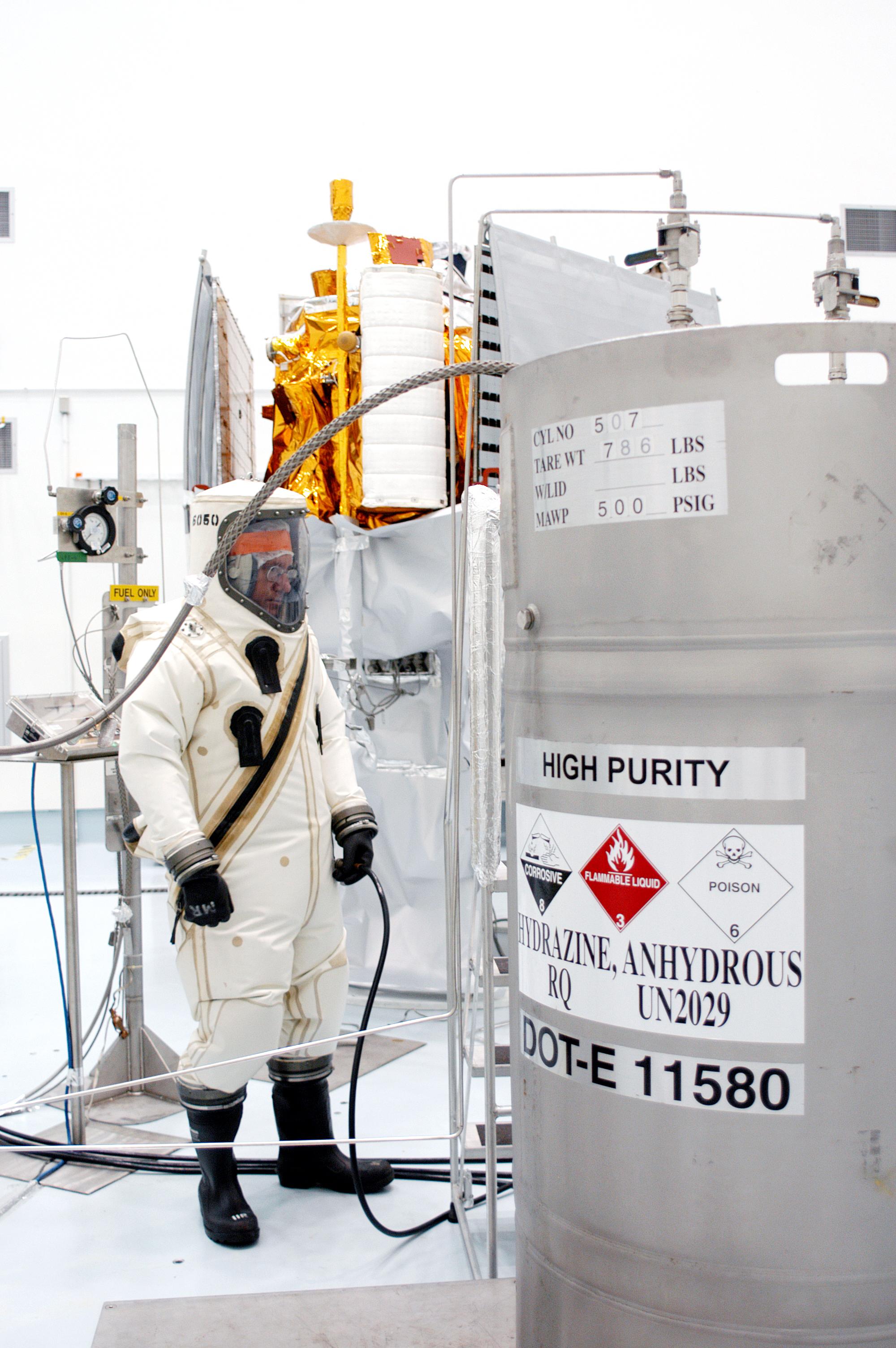|
Diazane
Hydrazine is an inorganic compound with the chemical formula . It is a simple pnictogen hydride, and is a colourless flammable liquid with an ammonia-like odour. Hydrazine is highly toxic unless handled in solution as, for example, hydrazine hydrate (). Hydrazine is mainly used as a foaming agent in preparing Polymeric foam, polymer foams, but applications also include its uses as a precursor (chemistry), precursor to polymerization catalysts, pharmaceuticals, and agrochemicals, as well as a long-term storable propellant for in-outer space, space spacecraft propulsion. Additionally, hydrazine is used in various rocket propellant, rocket fuels and to prepare the gas precursors used in air bags. Hydrazine is used within both nuclear and conventional electrical power plant steam cycles as an oxygen scavenger to control concentrations of dissolved oxygen in an effort to reduce corrosion. the world hydrazine hydrate market amounted to $350 million. About two million tons of hydra ... [...More Info...] [...Related Items...] OR: [Wikipedia] [Google] [Baidu] |
Pnictogen Hydride
Pnictogen hydrides or hydrogen pnictides are binary compounds of hydrogen with pnictogen ( or ; from grc, πνῑ́γω "to choke" and -gen, "generator") atoms (elements of group 15: nitrogen, phosphorus, arsenic, antimony, and bismuth) covalently bonded to hydrogen. Pnictogen trihydrides The simplest series has the chemical formula XH3 (less commonly H3X), with X representing any of the pnictogens. They take on the pyramidal structure (as opposed to the trigonal planar arrangement of the group 13 hydrides), and therefore are polar. These pnictogen trihydrides are generally increasingly unstable and poisonous with heavier elements. Like the simple hydrogen halides and chalcogenides, the pnictogen hydrides are water- soluble. Unlike other hydrides such as hydrogen sulfide and hydrogen fluoride, which form acidic aqueous solutions, ammonia dissolves in water to make ammonium hydroxide which is basic (by forming a hydroxide ion as opposed to hydronium). Phosphine is also water- ... [...More Info...] [...Related Items...] OR: [Wikipedia] [Google] [Baidu] |
Diazene
Diimide, also called diazene or diimine, is a compound having the formula (NH)2. It exists as two geometric isomers, ''E'' (''trans'') and ''Z'' (''cis''). The term diazene is more common for organic derivatives of diimide. Thus, azobenzene is an example of an organic diazene. Synthesis A traditional route to diimide involves oxidation of hydrazine with hydrogen peroxide or air. Alternatively the hydrolysis of diethyl azodicarboxylate or azodicarbonamide affords diimide: :(NCOOH)2 → (NH)2 + 2 CO2 Nowadays, diimide is generated by thermal decomposition of 2,4,6‐triisopropylbenzenesulfonylhydrazide. Because of its instability, diimide is generated and used ''in-situ''. A mixture of both the ''cis'' (''Z-'') and ''trans'' (''E-'') isomers is produced. Both isomers are unstable, and they undergo a slow interconversion. The ''trans'' isomer is more stable, but the ''cis'' isomer is the one that reacts with unsaturated substrates, therefore the equilibrium between them ... [...More Info...] [...Related Items...] OR: [Wikipedia] [Google] [Baidu] |
Diphosphene
Diphosphene is a compound having the formula (PH)2. It exists as two geometric isomers, ''E'' and ''Z''. Diphosphene is also the parent member of the entire class of diphosphene compounds with the formula (PR)2, where R is an organyl group. References {{Inorganic-compound-stub Phosphorus hydrides ... [...More Info...] [...Related Items...] OR: [Wikipedia] [Google] [Baidu] |
Triazene
Triazene is an unsaturated inorganic compound having the chemical formula N3 H3. It has one double bond and is the second-simplest member of the azene class of hydronitrogen compounds, after diimide. Triazenes are a class of organic compounds containing the functional group -N(H)-N=N-. Triazene, possibly along with its isomer triimide (HNNHNH), has been synthesized in electron-irradiated ices of ammonia and ammonia/ dinitrogen and detected in the gas phase after sublimation.Forstel, Tsegaw, Maksyutenko, Mebel, Sander, & Kaiser. "On the formation of N3H3 isomers in irradiated ammonia bearing ices: Triazene (H2NNNH) or Triimide (HNHNNH)", ''ChemPhysChem'', 2016, 17, 2726. References External links *IUPAC The International Union of Pure and Applied Chemistry (IUPAC ) is an international federation of National Adhering Organizations working for the advancement of the chemical sciences, especially by developing nomenclature and terminology. It is ... Gold Bookbr>definiti ... [...More Info...] [...Related Items...] OR: [Wikipedia] [Google] [Baidu] |
Azane
Azanes are acyclic, saturated hydronitrogens, which means that they consist only of hydrogen and nitrogen atoms and all bonds are single bonds. They are therefore pnictogen hydrides. Because cyclic hydronitrogens are excluded by definition, the azanes comprise a homologous series of inorganic compounds with the general chemical formula . Each nitrogen atom has three bonds (either N-H or N-N bonds), and each hydrogen atom is joined to a nitrogen atom (H-N bonds). A series of linked nitrogen atoms is known as the nitrogen skeleton or nitrogen backbone. The number of nitrogen atoms is used to define the size of the azane (e.g. N2-azane). The simplest possible azane (the parent molecule) is ammonia, . There is no limit to the number of nitrogen atoms that can be linked together, the only limitation being that the molecule is acyclic, is saturated, and is a hydronitrogen. Azanes are reactive and have significant biological activity. Azanes can be viewed as a more biologically ... [...More Info...] [...Related Items...] OR: [Wikipedia] [Google] [Baidu] |
Air Bags
An airbag is a vehicle occupant-restraint system using a bag designed to inflate extremely quickly, then quickly deflate during a collision. It consists of the airbag cushion, a flexible fabric bag, an inflation module, and an impact sensor. The purpose of the airbag is to provide a vehicle occupant with soft cushioning and restraint during a collision. It can reduce injuries between the flailing occupant and the interior of the vehicle. The airbag provides an energy-absorbing surface between the vehicle's occupants and a steering wheel, instrument panel, body pillar, headliner, and windshield. Modern vehicles may contain up to 10 airbag modules in various configurations, including: driver, passenger, side-curtain, seat-mounted, door-mounted, B and C-pillar mounted side-impact, knee bolster, inflatable seat belt, and pedestrian airbag modules. During a crash, the vehicle's crash sensors provide crucial information to the airbag electronic controller unit (ECU), including colli ... [...More Info...] [...Related Items...] OR: [Wikipedia] [Google] [Baidu] |
Rocket Propellant
Rocket propellant is the reaction mass of a rocket. This reaction mass is ejected at the highest achievable velocity from a rocket engine to produce thrust. The energy required can either come from the propellants themselves, as with a chemical rocket, or from an external source, as with ion engines. Overview Rockets create thrust by expelling mass rear-ward, at high velocity. The thrust produced can be calculated by multiplying the mass flow rate of the propellants by their exhaust velocity relative to the rocket (specific impulse). A rocket can be thought of as being accelerated by the pressure of the combusting gases against the combustion chamber and nozzle, not by "pushing" against the air behind or below it. Rocket engines perform best in outer space because of the lack of air pressure on the outside of the engine. In space it is also possible to fit a longer nozzle without suffering from flow separation. Most chemical propellants release energy through redox chemistry, m ... [...More Info...] [...Related Items...] OR: [Wikipedia] [Google] [Baidu] |
Outer Space
Outer space, commonly shortened to space, is the expanse that exists beyond Earth and its atmosphere and between celestial bodies. Outer space is not completely empty—it is a near-perfect vacuum containing a low density of particles, predominantly a plasma of hydrogen and helium, as well as electromagnetic radiation, magnetic fields, neutrinos, dust, and cosmic rays. The baseline temperature of outer space, as set by the background radiation from the Big Bang, is . The plasma between galaxies is thought to account for about half of the baryonic (ordinary) matter in the universe, having a number density of less than one hydrogen atom per cubic metre and a kinetic temperature of millions of kelvins. Local concentrations of matter have condensed into stars and galaxies. Studies indicate that 90% of the mass in most galaxies is in an unknown form, called dark matter, which interacts with other matter through gravitational but not electromagnetic forces. Observations ... [...More Info...] [...Related Items...] OR: [Wikipedia] [Google] [Baidu] |
Polymeric Foam
A polymeric foam is a foam, in liquid or solidified form, formed from polymers. Examples include: * Ethylene-vinyl acetate (EVA) foam, the copolymers of ethylene and vinyl acetate; also referred to as polyethylene-vinyl acetate (PEVA) * Low-density polyethylene (LDPE) foam, first grade of polyethylene (PE) * Nitrile rubber (NBR) foam, the copolymers of acrylonitrile (ACN) and butadiene * Polychloroprene foam or Neoprene * Polyimide foam * Polypropylene (PP) foam, including expanded polypropylene (EPP) and polypropylene paper (PPP) * Polystyrene (PS) foam, including expanded polystyrene (EPS), extruded polystyrene foam (XPS) and sometimes polystyrene paper (PSP) ** Styrofoam, including extruded polystyrene foam (XPS) and sometimes expanded polystyrene (EPS) * Polyurethane (PU) foam ** LRPu low-resilience polyurethane ** Memory foam ** Sorbothane *Polyethylene foam, as used in PEF rod * Polyvinyl chloride (PVC) foam ** Closed-cell PVC foamboard Closed-cell PVC foamboard is a lig ... [...More Info...] [...Related Items...] OR: [Wikipedia] [Google] [Baidu] |
Storable Propellant
A propellant (or propellent) is a mass that is expelled or expanded in such a way as to create a thrust or other motive force in accordance with Newton's third law of motion, and "propel" a vehicle, projectile, or fluid payload. In vehicles, the engine that expels the propellant is called a reaction engine. Although technically a propellant is the reaction mass used to create thrust, the term "propellant" is often used to describe a substance which is contains both the reaction mass and the fuel that holds the energy used to accelerate the reaction mass. For example, the term "propellant" is often used in chemical rocket design to describe a combined fuel/propellant, although the propellants should not be confused with the fuel that is used by an engine to produce the energy that expels the propellant. Even though the byproducts of substances used as fuel are also often used as a reaction mass to create the thrust, such as with a chemical rocket engine, propellant and fuel are two ... [...More Info...] [...Related Items...] OR: [Wikipedia] [Google] [Baidu] |
Power Plant
A power station, also referred to as a power plant and sometimes generating station or generating plant, is an industrial facility for the generation of electric power. Power stations are generally connected to an electrical grid. Many power stations contain one or more generators, a rotating machine that converts mechanical power into three-phase electric power. The relative motion between a magnetic field and a conductor creates an electric current. The energy source harnessed to turn the generator varies widely. Most power stations in the world burn fossil fuels such as coal, oil, and natural gas to generate electricity. Low-carbon power sources include nuclear power, and an increasing use of renewables such as solar, wind, geothermal, and hydroelectric. History In early 1871 Belgian inventor Zénobe Gramme invented a generator powerful enough to produce power on a commercial scale for industry. In 1878, a hydroelectric power station was designed and bui ... [...More Info...] [...Related Items...] OR: [Wikipedia] [Google] [Baidu] |
Oxygen Scavenger
Oxygen scavengers or oxygen absorbers are added to enclosed packaging to help remove or decrease the level of oxygen in the package. They are used to help maintain product safety and extend shelf life. There are many types of oxygen absorbers available to cover a wide array of applications. The components of an oxygen absorber vary according to intended use, the water activity of the product being preserved, and other factors. Often the oxygen absorber or scavenger is enclosed in a porous sachet or packet but it can also be part of packaging films and structures. Others are part of a polymer structure. Mechanism The first patent for an oxygen scavenger used an alkaline solution of pyrogallic acid in an air-tight vessel. Modern scavenger sachets use a mixture of iron powder and sodium chloride. Often activated carbon is also included as it adsorbs some other gases and many organic molecules, further preserving products and removing odors. When an oxygen absorber is removed ... [...More Info...] [...Related Items...] OR: [Wikipedia] [Google] [Baidu] |





.jpg)